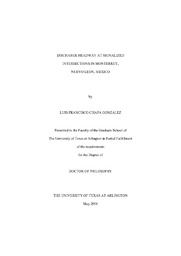| dc.contributor.author | Chapa, Luis F. | en_US |
| dc.date.accessioned | 2007-08-23T01:56:28Z | |
| dc.date.available | 2007-08-23T01:56:28Z | |
| dc.date.issued | 2007-08-23T01:56:28Z | |
| dc.date.submitted | December 2005 | en_US |
| dc.identifier.other | DISS-1221 | en_US |
| dc.identifier.uri | http://hdl.handle.net/10106/312 | |
| dc.description.abstract | Driver behavior has been the subject of study for almost 100 years. As a result, driver characteristics have been determined and used in the design of highway elements, both for interrupted and for free flow facilities. Signalized intersections represent the most typical interrupted flow facility, with driver reaction time and aggressiveness playing a key role in signal timing design and also in the assessing of intersection performance. These driver characteristics
were first determined in the United States in the late 1940's, identifying an average headway (in seconds) between consecutive vehicles as they react to light change from red to green and pass a common reference point. The additional time required to start the queue moving, known as the start-up lost time in seconds, was also identified. After many studies of these characteristics over time and despite the wide variability of the average headway as a result of varying conditions from site to site, it has been possible to adopt a specific value of average headway for conditions defined as base conditions. As a result, adjustment factors have been applied since the site conditions differ from the base ones. The vast majority of such studies have been conducted for United States conditions; however, it was worthwhile to determine these parameters for other conditions, specifically for Monterrey, México, and also to evaluate the effect of time of day and lane use variables in the subject approach of three different signalized intersections. The general result of the study was that average headway for Monterrey conditions is slightly higher to that of United States conditions. However only two or three vehicles incur start-up lost time, instead of five in the United States. Also, an important difference resulted in comparing two different procedures for headway calculation. | en_US |
| dc.description.sponsorship | Williams, James C. | en_US |
| dc.language.iso | EN | en_US |
| dc.publisher | Civil & Environmental Engineering | en_US |
| dc.title | Discharge Headway At Signalized Intersections In Monterrey, Nuevo Leon, Mexico | en_US |
| dc.type | D.Eng. | en_US |
| dc.contributor.committeeChair | Williams, James C. | en_US |
| dc.degree.department | Civil & Environmental Engineering | en_US |
| dc.degree.discipline | Civil & Environmental Engineering | en_US |
| dc.degree.grantor | University of Texas at Arlington | en_US |
| dc.degree.level | doctoral | en_US |
| dc.degree.name | D.Eng. | en_US |
| dc.identifier.externalLink | https://www.uta.edu/ra/real/editprofile.php?onlyview=1&pid=974 | |
| dc.identifier.externalLinkDescription | Link to Research Profiles | |

